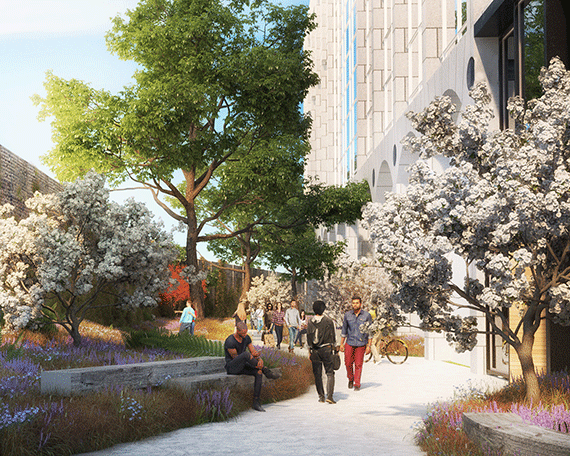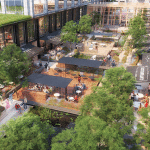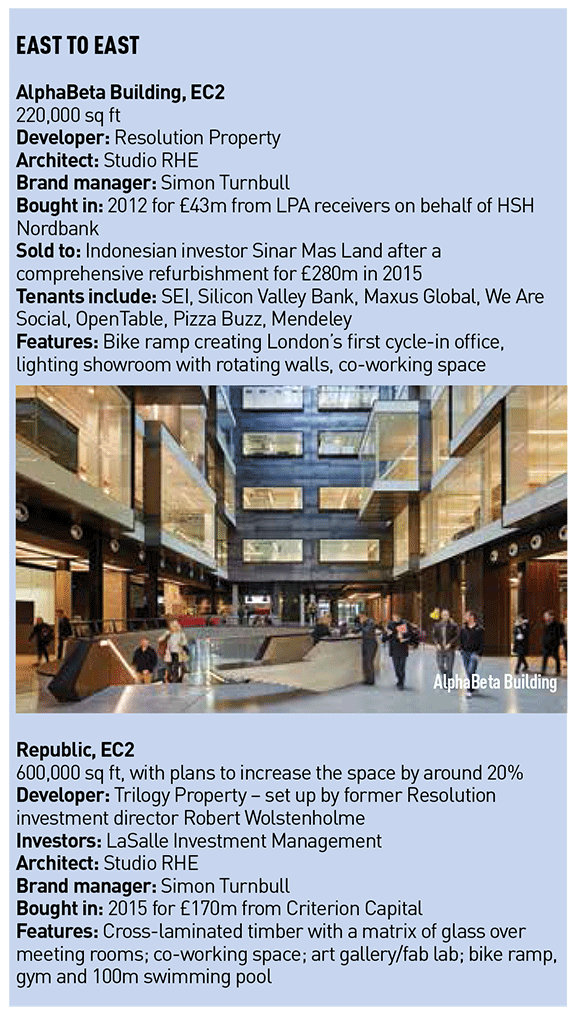Cedric Bleeker opens his coffee kiosk outside East India station, E14, every weekday morning at 6am.
Then the personalised ringtones start coming in, alerting him to the near arrival of his regular customers.
The South African barista, who has been trading in the same spot since 2008, noticed before anyone else that the area was underserving a growing workforce.
“I’ve definitely seen the area changing,” he says while frothing milk for a queue of afternoon customers. “You’ve got new residential developments down the road bringing people to the station, there’s the existing Tower Hamlets council offices, and we will see what happens when this opens.”
He points behind him to where a large blue, yellow and white mural is being painted on the high wall of East India Dock. The colours have been chosen by Trilogy Property and approved by LaSalle Investment Management for the launch of their rebranded office development, Republic.
The major refurbishment of the four post-modern buildings, bought from Criterion Capital in November 2015 for £170m, will comprise 600,000 sq ft of offices as part of a new east London campus.
After plans by Criterion to demolish the block and build a 1,389-unit PRS development failed to get off the ground, the new plans signal a revival of the existing block in an area of cheap rents close to Canary Wharf. The scheme has been masterminded by the team behind the AlphaBeta building, EC2: Trilogy managing director Robert Wolstenholme, formerly investment director at Resolution Property, along with Richard Hywel Evans of architects Studio RHE and marketing strategist Simon Turnbull.
With rents of around £35 per sq ft – half the costs of Shoreditch, E1, and one-third of those in the West End – the team hope to replicate the success of AlphaBeta in drawing businesses further east. But will Republic appeal to London’s next generation of disruptive creative and tech businesses?
East to east
Wolstenholme recalls doing guided tours of Shoreditch for US fund managers in 2010, walking up and down Shoreditch High Street starting at Pizza East, when no-one knew about the area. The 220,000 sq ft AlphaBeta building was fully let in 18 months and rents surged from £45 to £65 per sq ft. In October 2015, it was sold to Indonesian investor Sinar Mas Land for £280m – a 4% yield.
Now the team thinks it can repeat that success at Republic.
“The first time we came down to the building, we both just said, ‘Oh my god, this is kind of history repeating itself’,” says Wolstenholme. “The whole story of the eastward migration of people fits exactly with everything that I’d been witnessing.
“There was definitely a sense that in the same way that people moved from Soho to Shoreditch to Whitechapel, we were saying Shoreditch is getting to more than £60 per sq ft, so people might start moving from Shoreditch to Whitechapel to further east.”
It all centres on talent. The campus is easily accessible from the six boroughs in east London which JLL research has found together hold 45% of the capital’s housing supply. CBRE’s Dan Hanmer, who is joint office leasing agent at Republic with Allsop, says this means it is at the centre of a “perfect storm” between the talent businesses wanting to recruit and the socio-demographic that seeks to work closer to home.
“All we are doing is following the working population,” says Hywel Evans. “So the millennials will be living east of here. Actually the journey from Bank to here is easy. And if you look at the working population, it’s basically our demographic.”
Access to talent was also an important driver for LaSalle, which is fully funding the offices’ purchase and renovation through an investment from a group of seven of its UK pension plans and endowments.
“For those investors, we very much focus on the fundamentals,” says regional director Andrew Meyrick. “And three key secular trends which we reiterate to them are demographics, technology and urbanisation. And I think East India Dock plays very well into those three.”
The plan is for long-term asset management of the scheme. “It was an opportunity not just to refurbish an office building, but to change a space,” Meyrick says. “Because there’s a critical mass here, there’s enough space outside that you can create an environment that the modern growth industries want to be in.”
Post-Shoreditch
AlphaBeta was about connecting the tribes of Shoreditch with the suited City workers, and Republic is a step forward in that evolutionary process.
“I think those boundaries between being a beard and being a suit are meaningless now,” says Turnbull, who came up with both the AlphaBeta and Republic brands.
“If a bank [occupier] has got the right attitude and it is going to contribute and fit in here, then I’m all ears. The little techie companies want to be standing at the bar with the guy who’s got the influence, the power, the foresight, the money, to actually help his business.”
“It’s no longer about tech businesses, per se,” Wolstenholme says. “Because technology and people are actually at the heart of everything, of all businesses. It’s more about having the right attitude than being a particular kind of business.”
Yet tech remains at the heart of the campus – which is next door to Global Switch and London Telehouse – the biggest conurbation of data centres in the world and the place where Tim Berners-Lee first fired up the internet.
While the first buildings to be refurbished – Anchorage House (225,000 sq ft) and Capstan House (200,000 sq ft) – are due to complete in 2017, the team is busy fast-tracking a floor to create a 9,000 sq ft co-working space complete with a raised deck and bar with views over Canary Wharf.
Flexible working space is also an important part of the scheme’s design. Timber technology will transform the main interior into a matrix of glass-covered spaces upon which occupiers can stamp their own identities. And with an emphasis on the importance of experience, the team plans to curate the ground floor level’s leisure and retail offering carefully, seeking to attract a variety of independent global food offer restaurants, a micro-brewery, independent coffee shop, tea house, wholefood delicatessen and bakery.
Where AlphaBeta introduced London’s first cycle-in office with a bike ramp, Republic will feature a 100m swimming pool and two-storey gym so workers will be able to complete a whole triathlon at the scheme. “We’re still going to have the bike ramp,” says Hywel Evans. “But how do we take it to the next stage? It’s about triathlon now.”
To help accelerate the area’s revival, the team has commissioned Yuri Pattison and the Chisenhale Gallery to commission events including an outdoor cinema, art exhibitions and music festivals.
Outside, a landscaped area will be divided into “neighbourhoods”, each with a different theme and planting that references the spices of the original East India Company, with cafés and bars spilling out into a central zone.
Republic
During the height of the British Empire, East India Dock was the arrival point for ships carrying cotton, silk, tea, opium and spices.
The Republic team wants to celebrate that history and the existing immigrant community and connectivity with the creation of its own mini-state.
“A republic is usually a fairly positive thing,” Turnbull says. “It’s egalitarian, it’s got quite a democratic feel to it. And it has that feeling of people coming together, in their own place, doing a thing that has a common bond.”
Despite being an island site, Republic is superbly well-connected. Nearby is the Docklands Light Railway station overlooking Canary Wharf, and the development is 10 minutes from City Airport, a short walk to the Jubilee Line at Canning Town and the proposed new Crossrail station, and it is just off the cycle superhighway and A13.
It is also unrivalled in terms of data connectivity.
“That data, all those racks over there, could actually put at risk the very thing we are trying to do here – create jobs,” says Wolstenholme.
“But then you think about which of the jobs are going to survive in that world [of robotics and artificial intelligence], we think it’s about creative thinking – humanity and creative thinking. And we can bring to this spot not only the god-given data that’s here, but actually create the most inspiring, creative community in the world, right next door to that – and do something knockout, that’s up there, world-beating. Why not?”
Republic has a double meaning: re-public, as in, bringing in the people. “There’s a little bit of pioneering about Republic, a little bit about changing things,” Turnbull says. “It’s a statement.”
LaSalle’s Meyrick spent some time testing the ideas of “republic” and “insurgency”. “That was my institutional hat testing,” he says.
“We’re constantly trying to challenge poor Andrew, who’s there to say, ‘Now calm down’, but it’s great,” says Wolstenholme. “We’re loving it, it’s a great partnership.”
Walking back to East India station, the team takes a look at the painted mural, which will be accompanied eventually by Republic’s own flag. “I’m thinking of adding flashing red dots to signal the disruption,” Wolstenholme says, waving his hands in the air. Meyrick laughs. “But have you thought about the planes coming into City Airport?”
The battle between the rebels and the establishment is already being played out.
• To send feedback, email louisa.clarence-smith@estatesgazette.com or tweet @LouisaClarence or @estatesgazette
















